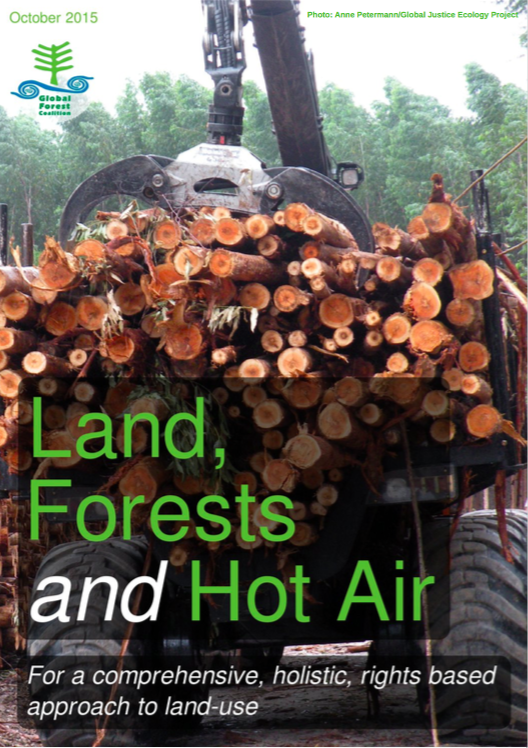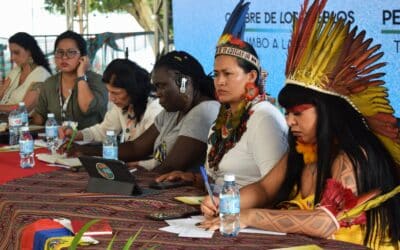15 Nov 2015: The Global Forest Coalition (GFC) [1] launched a new briefing paper [2] today, providing a critical overview of the problem of current carbon accounting rules in the land use and forests sector, under the acronym LULUCF [3]. These are creating loopholes for real emission cuts and will undermine any new climate agreement.
The paper highlights that current carbon accounting rules are too flexible, confusing and allow several forms of cheating. In the case of the Kyoto protocol, Annex I parties were allowed to earn large amounts of fraudulent surplus credits [4]. They also benefitted from future forest management activities that were yet to be implemented, allowing polluters to continue emissions.
“There are no effective methodologies to comprehensively account for indirect land use change and leakage in general and current accounting rules accept monoculture tree plantations as forests.” explains Mary Lou Malig, campaign coordinator of GFC. “As a result such accounting mechanisms encourage a reductionist view of land and forests as carbon and aggravate environmental and social problems by providing incentives for the expansion of harmful monoculture tree plantations.”
“Proposals to strive for net zero emissions are based on the naive assumption that emissions in one sector can be offset by sequestration of emissions somewhere else. Or that miracle technologies like “bioenergy with carbon capture” (which currently doesn’t even exist), can miraculously defy the laws of physics by generating energy while simultaneously sucking greenhouse gases out of the atmosphere. Techno fixes and wishful thinking won’t get us anywhere,” said Rachel Smolker codirector of Biofuelwatch and Board member of GFC.
The GFC briefing paper recommends rejecting the carbon accounting framework, which so far has allowed for massive cheating in both land use and other sectors, and has allowed developed countries to escape from their historical accountability to cut their emissions deeply at source. It also points out that bioenergy should not be classified as a renewable source of energy, as biomass does not immediately regrow after it is burnt. It also calls for a clear rejection of REDD+ [5], carbon offsets and other mechanisms that displace communities and replace old, native, biodiverse ecosystems and forests with monoculture tree plantations.
GFC calls on governments to take a holistic approach to sustainable land use and agriculture based on existing international agreements such as the Sustainable Development Goals [6], the UN voluntary guidelines on responsible governance of land tenure, fishing and forests [7], the Convention on Biodiversity [8], the UN Declaration on the Rights of Indigenous Peoples [9] and the Convention to Combat Desertification [10], as well as key documents expressing the view of social movements like the Nyeleni Declaration on Food Sovereignty [11]. Climate change resilience should be an integral and important goal of such practices.
“The customary practices of Indigenous peoples, local communities and women, and their traditional knowledge, do not only contribute to biodiversity conservation and restoration, they also form a cornerstone for ecosystem-based climate resilience. These practices almost always have very significant climate mitigation co-benefits and must be prioritized in any potential future climate deal,” emphasizes Hindou Oumarou of the Association of Indigenous Women in Chad, one of GFC’s Board members.
Notes
[1] Global Forest Coalition is a worldwide coalition of almost 80 NGOs and Indigenous peoples’ organizations from 53 different countries striving for rights-based, socially just forest conservation policies. [2] https://globalforestcoalition.org/wp-content/uploads/2015/11/LULUCF-paper-EN.pdf [3] Land use, land-use change and forestry (LULUCF) is defined by the United Nations Climate Change Secretariat as “A greenhouse gas inventory sector that covers emissions and removals of greenhouse gases resulting from direct human-induced land use, land-use change and forestry activities.” see: http://unfccc.int/land_use_and_climate_change/lulucf/items/1084.php [4] In the case of the Kyoto Protocol where a gross-net approach is applied that allows Annex I parties to compared its emissions in a given year to an assigned amount of GHG a party agreed upon. In case the assigned amount is higher than the net emissions, the party books the saved emissions as credits. In case it is lower, debts are booked. Looking back at the first commitment period of the Kyoto Protocol, it shows that the assigned removals were set far too low and almost all parties exceeded the cap, which resulted in large amounts of surplus credits for most parties. [5] Reducing Emissions from Deforestation and Forest Degradation and enhancing carbon stocks (REDD+) is an effort to create a financial value for the carbon stored in forests, offering incentives for developing countries to reduce emissions from forested lands. See more at: http://www.un-redd.org/aboutredd [6] The Sustainable Development Goals (SDGs) adopted by the UN in September 2015 have been agreed as a follow on from the Millennium Development Goals (MDGs) to fulfill goals like ending global poverty, deforestation, hunger and gender inequality by 2030, ensuring sustainable consumption and production patterns, combatting climate change, promoting sustainable agriculture among others See https://sustainabledevelopment.un.org/focussdgs.html [7] The Voluntary Guidelines on the Responsible Governance of Tenure of Land, Fisheries and Forests in the Context of National Food Security promote secure tenure rights and equitable access to land, fisheries and forests as a means of eradicating hunger and poverty, supporting sustainable development and enhancing the environment. See: http://www.fao.org/nr/tenure/voluntary-guidelines/en/ [8] The Convention on Biological Diversity (https://www.cbd.int) has adopted a large number of work programs and other decisions on the conservation forests, drylands, wetlands and other ecosystems and sustainable agriculture, as well as decisions that urge climate policy makers to take into account the impacts on biodiversity of climate mitigation policies. [9] The United Nations Declaration on the Rights of Indigenous Peoples sets out the individual and collective rights of indigenous peoples, as well as their rights to culture, identity, language, employment, health, education and other issues. [10] The United Nations Convention to Combat Desertification in Those Countries Experiencing Serious Drought and/or Desertification, Particularly in Africa (UNCCD) is a Convention to combat desertification and mitigate the effects of drought through national action programs that incorporate long-term strategies supported by international cooperation and partnership arrangements. See: http://www.unccd.int/en/about-the-convention/Pages/About-the-Convention.aspx. [11] The Nyéleni declaration on Food Sovereignty was produced by more than 500 peasants, fisher folk, pastoralists, indigenous people and consumer group representatives from more than 80 countries in 2007 to articulate their vision of food sovereignty. See: http://nyeleni.org/spip.php?article290
| For more information please contact:
Ashlesha Khadse (Media Officer) Cell and whatsapp: +52 967 111 0424 |
Website: https://globalforestcoalition.org/media
Social media Facebook: bit.ly/gfc123 Instagram: global.forest Twitter: @gfc123
|




